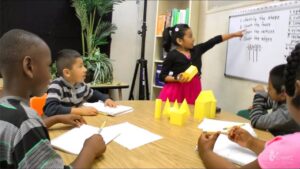Artificial intelligence (AI) presents several opportunities in the field of education, especially in the teaching and learning process. Teachers can customize lessons, shorten paperwork, and promote a greater understanding of basic ideas by utilizing AI tools and methodologies. In my course prototype of Grade 1, AI integration improves teaching efficacy and the desired outcomes for students.
 https://images.app.goo.gl/4y6vSmjheCMoeWhGA
https://images.app.goo.gl/4y6vSmjheCMoeWhGA
Integrating AI concepts into a course prototype could be immensely beneficial for teaching and learning. This is how I would go about my course prototype:-
Collaborative Learning:-
- Through group projects, collaborative learning in AI educates students with real-world abilities by simulating multifaceted interactions among professionals.
- As students share thoughts and opinions, it enhances the understanding and problem-solving abilities of the learners.
- Collaborative projects encourage creativity and innovation through diverse viewpoints and approaches.
- Collaborative learning in AI education improves academic knowledge and fosters the development of interpersonal and career abilities that are essential for job prospects.
- AI could help me to promote diversity and interactions, in which students can be separated into smaller groups and the students studying a specific living organism such as plants or animals or any other organism.
 https://images.app.goo.gl/sGUTJFFT7in6Zmof7
https://images.app.goo.gl/sGUTJFFT7in6Zmof7
Interactive Learning Tools:-
- Interactive learning tools actively involve the students in the learning process. These tools have different forms, like interactive workshops, as well as virtual games.
- Provide numerous opportunities for learners to experiment with AI algorithms where they explore, manipulate, and see outcomes in an adequate time.
- These resources can help teachers to improve student participation and promote a deeper understanding of AI thoughts.
Virtual Field Trips :-
- Virtual field trips develop critical thinking skills and ecological awareness by simulating real-world scenarios and challenges.
- Students can interact with virtual environments, deepening their understanding of ecosystems without any physical constrained. Virtual trips give students the chance to investigate a variety of ecosystems and see creatures in their natural environments.
 https://images.app.goo.gl/AvH7LbK7Bxx3wAqq8
https://images.app.goo.gl/AvH7LbK7Bxx3wAqq8
I would want to learn more about ChatGPT for my course prototype which help me to go deeply into my topic needs and characteristics of living things for Grade 1. I believe this tool can help me effectively with establishing tasks that are straightforward for students and creating an assessment tool to evaluate the feedback of the students.
Personalized learning –
Adaptive learning platforms with artificial intelligence (AI) can assess students’ learning styles and behaviors and modify the course material appropriately. This ensures that every student gets materials and attention appropriate to their unique learning style. In addition, AI systems evaluate student performance continuously and offer immediate feedback. AI could help me to provide the feedback that can be customized to strengthen the strengths or address particular areas of weakness. For example, if a student consistently makes errors in finding the living and nonliving things, then AI provides me with additional practice problems or suggests supplementary resources focused on that topic.
Using Data Analytics to Monitor Performance-
AI-powered data analytics solutions can collect and evaluate information on student performance, involvement, and learning patterns. This makes them useful for performance tracking. These observations can help me to identify issues with pupils immediately, customize solutions to meet each student’s requirements, and improve course materials and teaching methods with time.
To sum up, integrating AI into the classroom offers an innovative approach to education and learning. AI improves engagement among students, encourages critical thinking, and personalizes education to meet each student’s needs through collaborative learning, interactive tools, virtual field excursions, personalized learning, and data analytics. Educators may encourage kids to perform well academically and prepare them with essential abilities for the future by utilizing AI technologies to create flexible and adaptable learning environments.
Hello Taranpreet, I really enjoyed your post and that it focused on the positives of AI. I am impressed with the variety of examples you provided. As someone who is very confused about AI and how to incorporate it into my own class, your post is very appreciated!